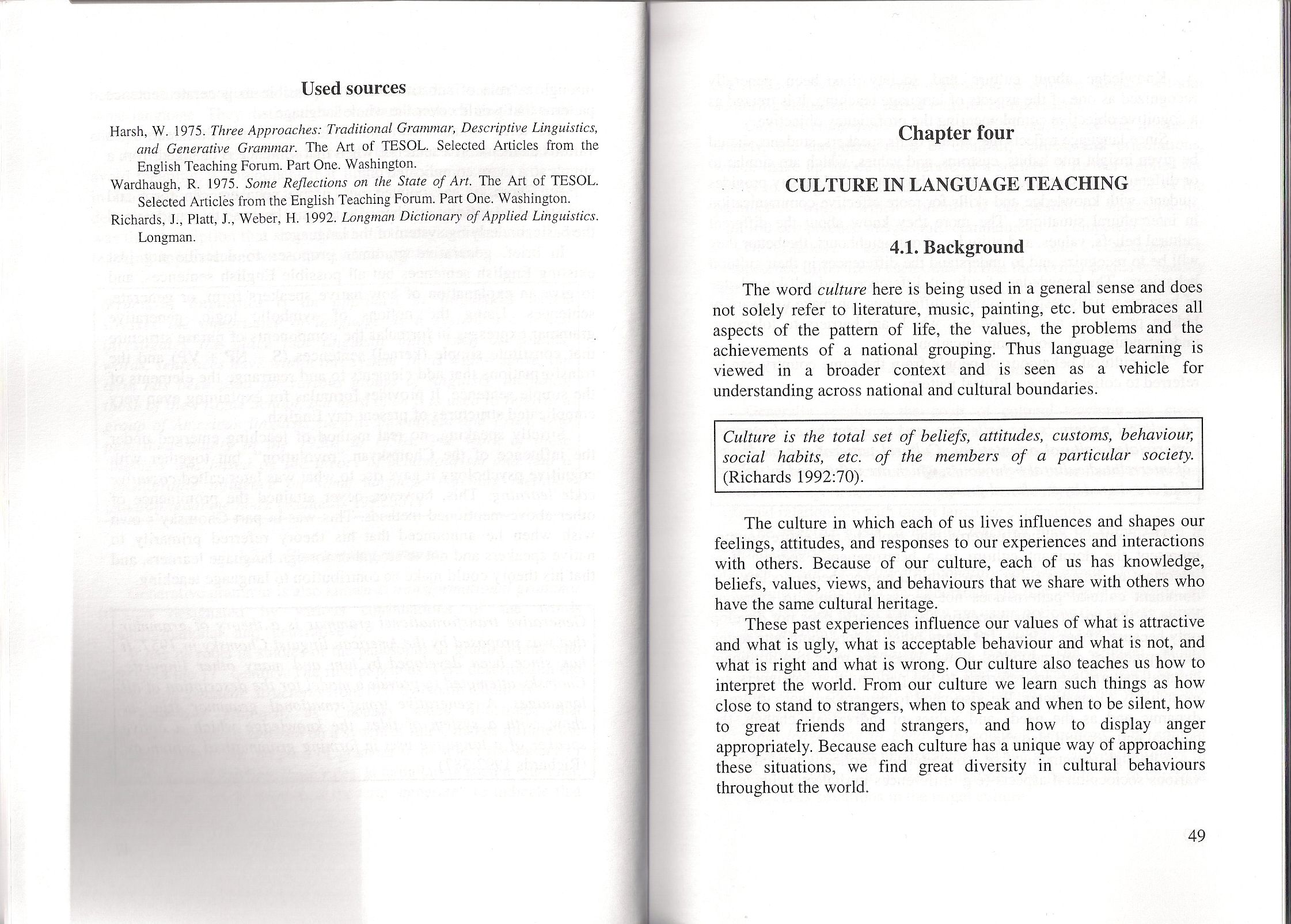skanowanie0024 (24)

Used sources
Harsh, W. 1975. Three Approaches: Traditional Grammar, Descriptivę Linguistics, and Generative Grammar. The Art of TESOL. Selected Aiticles from the English Teaching Forum. Part One. Washington.
Wardhaugh, R. 1975. Some Reflections on the State of Art. The Art of TESOL.
Selected Articles from the English Teaching Forum. Part One. Washington. Richards, J., Platt, J., Weber, H. 1992. Longman Dictionary of Applied Linguistics. Longman.
Chapter four
CULTURE IN LANGUAGE TEACHING 4.1. Background
The word culture here is being used in a generał sense and does not solely refer to literaturę, musie, painting, etc. but embraces all aspects of the pattem of life, the values, the problems and the achievements of a national grouping. Thus language learning is viewed in a broader context and is seen as a vehicle for understanding across national and cultural boundaries.
Culture is the total set of beliefs, attitudes, customs, behaviour, social habits, etc. of the members of a particular society. (Richards 1992:70).
The culture in which each of us lives influences and shapes our feelings, attitudes, and responses to our experiences and interactions with others. Because of our culture, each of us has knowledge, beliefs, values, views, and behaviours that we share with others who have the same cultural heritage.
These past experiences influence our values of what is attractive and what is ugly, what is acceptable behaviour and what is not, and what is right and what is wrong. Our culture also teaches us how to interpret the world. From our culture we leam such things as how close to stand to strangers, when to speak and when to be silent, how to great friends and strangers, and how to display anger appropriately. Because each culture has a uniąue way of approaching these situations, we find great diversity in cultural behaviours throughout the world.
49
Wyszukiwarka
Podobne podstrony:
Fig# Gif 0 4 8 16 19 24 32 Source Port DestinationPort Seąuence Number A ckno wie dgement Numb
skanowanie0024 24 * Przydatne obliczenia Opór cieplny całej warstwy niejednorodnej: 1
skanowanie0031 (24) noścl. Przy zbyt prostolinijnym trasowaniu linia kolejowa przebiega nieraz zbyt
skanowanie0048 (24) zaś niewielką szansę stwarzało lekturze powszechnej, wspólnej, budzącej społeczn
skanowanie0015 (24) Zadanie 1 = Przeciwwskazaniem do stosowania surowców roślinnych, takich jak: kor
skanowanie0017 (24) o bofól a^: > tnficAoła h* w 20,nu /zony /rrf u ao^/<* * <&uą tcuy
skanowanie0028 (24) ; r * • * * • i ~s r y- i ’ * ^ * I Tl I *! : • .; • :.* ■ " . : ( ?vt 4 i
skanowanie0035 (24) Zadanie * (2 pkt) Schemat przedstawia jedną z wad wzroku, a) Podaj nazwę wady wz
skanowanie0039 (24) atmosferycznego, ale niezwykle wrażliwego na toksyczne działanie tlenu. W hetero
więcej podobnych podstron